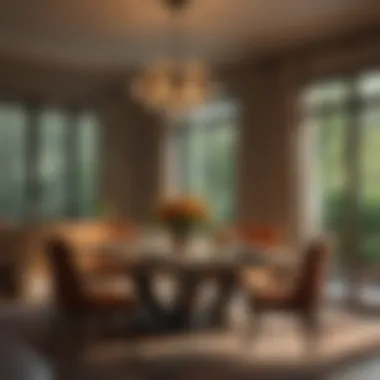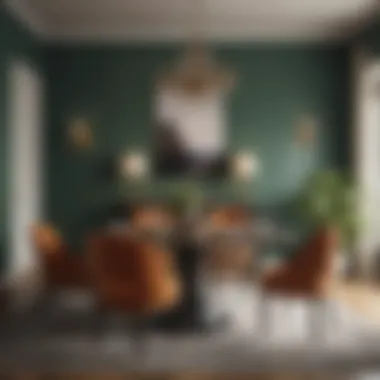Choosing the Perfect Color for Your Dining Room Space


Intro
Choosing the right color for a dining room is more than just a cosmetic decision; it is an essential aspect of creating a pleasant eating environment. The right hues can shape an atmosphere, subtly influence mood, and encourage authentic social interactions. Understanding the effects different colors have is crucial for homeowners and design enthusiasts alike.
This section breaks down practical advice and insights to guide you through the color-selection process. It delves into various factors like psychological influences, smart combinations, and aesthetics related to size and lighting in a dining space.
Interior Design Tips
When it comes to selecting a color for your dining room, consider both the physical and psychological impact it can create. Colors stimulate feelings and thoughts, reinforcing certain types of conversations or interactions. Therefore, deciding on typical colors is fundamental.
Trendy Design Ideas
Individuals should keep abreast of current trends that dictate popular color choices. Popular schemes like muted tones or earthier shades create relaxing settings. Colors such as terracotta, sage green, or deep navy are gaining traction, offering richness to the space while still maintaining warmth.
Color Schemes and Combinations
Creating an appealing color scheme involves blending primary hues with complimentary tones. This is achieved through variations:
- Monochromatic: Use shades of a single color for a unified look.
- Analogous: Combine colors next to each other on the color wheel, creating harmony.
- Complementary: Pair contrasting colors for a vibrant balance.
Utilizing color palettes creates a visual allure, enhancing the range of features present in a dining area. Consider adding accent colors through decorative items like placemats or vases, which can breathe life into a specific theme.
Furniture Arrangement Techniques
The layout of furniture plays a pivotal role too. Arrange the seating in a way that makes interactions simple while still allowing everyone easier access to the dining table. Dark hues in larger rooms can create warmth, while lighter shades are better suited for smaller spaces as they give an illusion of expansion.
"The arrangement not only influences the feeling but also forms the experience at the dining table."
Consider transitional patterns as well, transitioning walls from one color into another can establish different tones while keeping a fluid styling. Smart layering boosts visual interest.
Preamble to Dining Room Colors
Choosing the appropriate color for dining rooms is not just a matter of aesthetics. It profoundly affects how the space feels, influences the experiences of both the hosts and guests, and can modify social dynamics. This introductory section dives into the importance of understanding color choices as a strategic decision in interior design and how these colors can transform dining spaces.
Importance of Color in Interior Design
Color plays a pivotal role in interior design, serving as more than mere decoration. It is a fundamental aspect that can dictate atmosphere and influence emotional responses. When one enters a space painted in rich, warm hues, storytelling through ambiance is unavoidable. Warm tones typically promote feelings of coziness and familiarity, encouraging social interaction. Conversely, cooler shades can introduce calmness but might affect the social engagement level in that space.
Benefits of Thoughtful Color Selection
- Mood Creation: Carefully selected colors can make the dining experience feel more joyful or relaxing.
- Spatial Perception: Lighter hues can simulate a sense of space, while darker shades might add sophistication.
- Brand Identity: If the home resembles an extension of personal style, a color palette can affirm identity.
Understanding these principles of color choice enhances the dining room's function in daily life, making dining a pivotal engagement rather than a mere necessity.
Brief Overview of Color Psychology
Color psychology delves into the way colors impact human behavior and emotions. Different shades trigger various emotional responses, profoundly affecting vibe present in dining areas.
Emotional Effects of Color
- Red: Can stimulate appetite and enthusiasm. Often chosen for dining areas, it engages vitally with one’s senses during meals.
- Blue: Generally associated with tranquillity, allowing guests to feel relaxed but may suppress appetite.
- Yellow: Often linked to joy and positivity, yellow can create a lively environment conducive to shared meals among friends and family.
Color influences so much more than just beauty. It sets the foundation for experiences in the space it occupies.
In summary, inexperienced eyes could overlook the essential role of color in a dining room. A comprehensive understanding leads to smarter choices that boost both aesthetics and human interaction within the space while also addressing more broad concepts like preferences and cultural significances, cementing color's fundamental role in progressing interior design at a sophisticated level.


Factors Affecting Color Choice
The process of selecting a color for your dining room can be intricate and is influenced by several factors. Understanding these elements is crucial for achieving a harmonious atmosphere that effectively supports the overall design of your home. The color you choose will not only transform the look of the room but can also affect the emotional experience of those who gather there. Each factor plays a role in shaping your decision-making process and determining how well the color integrates into your existing space.
Room Size and Layout Considerations
Room dimensions cannot be ignored when selecting a color. A small dining room might benefit from lighter hues, which can help it seem more expansive. Light colors like soft white or pale blue can reflect light, enhancing the sense of openness. On the other hand, larger rooms can handle darker hues, such as deep navy or charcoal gray, providing a more intimate feel.
Moreover, the layout of furniture also dictates color choices. If your dining table is centrally placed, a striking color might further emphasize its importance in the room. Yet, for dining areas located near kitchens or living rooms, a color that complements those spaces can promote visual flow and harmony. Considering these aspects ensures that your choice caters to both aesthetic appeal and functional design.
Lighting Conditions and Its Impact
Natural lighting fundamentally influences how colors appear within a space. A well-lit room can make different color schemes come to life. Colors may look stunning in daylight yet lose their charm once artificial light takes over. For example, warm tones like rich yellows can appear inviting under incandescent lights but might look dull under cooler fluorescent options.
It is wise to assess how light shifts throughout the day in your dining area, factoring in both sunlight exposure and indoor lighting fixtures. You might experiment with different shades and finishes at various times to observe how they behave. Understanding lighting will guide you to select shades that enhance the space when illuminated.
Existing Design Elements
Your existing design elements significantly impact the color selection process. From furniture and wall textures to flooring and any visible decorative items, their colors, styles, and treatments should influence your choice. If you have dark wood furniture, expanding that palette with rich earth tones can establish a strong base and elevate the space's elegance. If your decor skews more modern, neutral shades may be more adaptive.
- Understanding the principles of color cohesion will help integrate new choices seamlessly into your preconceived design.
It can be formulaic to randomly throw colors onto the walls without regard for the entirety of the space. Instead, identify at least two main tones from your existing design features and build on them. A thoughtful and decisive approach will lead to a color scheme that feels planned, merging with the expression of your unique style.
Popular Color Choices for Dining Rooms
When it comes to selecting colors for dining rooms, understanding the most popular options is essential. Popular colors not only set the tone of the space but also reflect personal tastes and preferences. They can influence the atmosphere during meals, gatherings, or even quiet evenings. Each color option has distinct characteristics that can affect social interactions and mood.
Neutrals: Timeless and Versatile
Neutral colors, like beige, gray, and white, are often preferred for dining rooms due to their flexibility. These shades create a calm background that can accommodate various styles of decor, from contemporary to rustic. Neutrals allow for easy updates; you can change accessories, linens, or wall art without clashing with the base color. Additionally, they enhance natural light, making the space feel larger and more open. If you choose a neutral palette, consider different textures, such as wooden furniture or fabric accents, to add depth.
Bold Colors: Making a Statement
Bold colors, including deep reds, royal blues, and vibrant yellows, are perfect for those looking to make a statement. These hues can evoke strong emotions and inject energy into the dining area. Choosing a bold color can also encourage conversation and high spirits during meals. However, it is crucial to balance these colors to avoid overwhelming the space. Pairing them with neutral elements or lighter accents can help maintain an inviting ambiance. If you want to feature a bold color, consider using it on an accent wall or through smaller decor pieces.
Pastels: Soft and Inviting
Pastel colors like soft pink, mint green, and light lavender bring a sense of calmness and welcome warmth. These shades are particularly effective in making the dining room feel cozy without feeling locked in. Pastels are often associated with openness and tranquility, enhancing the overall dining experience. They work well with various styles, from modern to vintage. Using pastel colors allows for creativity with patterns, textures, and materials, offering an inviting surface without dominating the space.
Dark Shades: Creating Intimacy
Dark shades such as navy blue, charcoal, or forest green promote intimacy and comfort. These colors work well in larger spaces, bringing warmth and seclusion to family dinners or social events. Darker tones can enhance architectural features or unique furnishings. To offset the potential weight of dark colors, integrate good lighting and colorful accessories. Using mirrors can also help reflect light and brighten the atmosphere. The result is an elegant dining space that feels open yet intimate.
Color can ignite feelings, illuminate creativity, and shape conversations. Choosing wisely will enhance your dining experience.
Innovative Color Combinations
Selecting appropriate color combinations is vital for achieving the desired aesthetic and emotional impact in a dining room. Innovative color combinations can elevate the space, allowing homeowners to express their distinctive style while enhancing the vibe of social gatherings. Moreover, blends of different colors can harmonize elements in the room, creating a calm or stimulating atmosphere depending on the occasion. Balancing colors correctly may also maximize the light in the room, refining spatial perception and overall warmth.
Monochromatic Schemes
A monochromatic color scheme involves selecting various shades and tints of a single color. This method simplifies decorating a dining room while still allowing for depth and interest. Different tones provide depth, which creates a seamless transition from one area to another, promoting a sense of unity and stability. For example, opting for various shades of blue can invoke tranquility, while greens promote a refreshing flush reminiscent of nature. To achieve a complete look,
- Choose a base hue as the main color.
- Incorporate lighter and darker variations to add dimension.
- Use complementary materials and textures, such as wood or linen, to enhance the rich layers of the monochromatic palette.


Complementary Color Pairings
Complementary colors are located opposite each other on the color wheel. The contrast between these colors creates a dynamic and vibrant space. Using complementary colors effectively usually involves two main hues that represent two different facets of emotion and energy. For instance, pairing red, a stimulating color, with green, which is calming chiefly, can draw attention whiel keeping comfort present. Strategies for a proficient complementary palette can be as follows:
- Identify your primary color and find its complementary counterpart within the wheel.
- Use the dominant tone more frequently and save the second hue as an accent through decor or accessories.
- Maintain balance to avoid overwhelming the senses—too much contrast can cause disarray instead of harmony.
Analogous Colors for Harmony
Analogous colors are adjacent to each other on the color wheel. Using this scheme provides a harmonious effect that soothes the eye. Selection of analogous colors generates a collaborative flow between areas of the dining space. Classic examples include the combinations of blue, blue-green, and green or red, red-orange, and orange. When planning these decorating choices, keep these tips in mind:
- Choose three colors that sit next to each other on the color wheel.
- Use patterns to incorporate these hues naturally within textiles or wall art.
- Invest in the art of blending shades within furniture or decorative pieces to achieve a complete and polished atmosphere.
Incorporating innovative color combinations into a dining space is about more than aesthetics; it also influences the moods and interactions of those who gather within. Therefore, understanding these color theories greatly improves the overall dining experience.
Trends in Dining Room Color Selection
Understanding trends in dining room color selection is pivotal in creating spaces that reflect contemporary styles while also remaining practical. As social norms evolve, so do color preferences, making it essential for homeowners and interior design enthusiasts to stay informed about the latest hues and combinations that dominate space hesitation and excitement.
Current trends not only favor looks but prioritize functionality and sustainability as well. Consumers today often seek colors that work harmoniously in various circumstances while ensuring a welcoming ambiance for guests. Staying updated on trends encourages making informed decisions, providing a balance between personal style and wider aesthetics. This knowledge aids in enhancing overall satisfaction with their dining environments.
Color Trends in Interior Design
This year, several color trends have emerged, reflecting both a desire for comfort and a nod towards bold expressions. Noticing prevailing themes in the palette of 2023 adds critical context around the choices homeowners face.
- Warm Earth Tones: Colors like terracotta and taupe are on the rise. They add warmth and evocativeness, making them ideal for dining areas where comfort is key.
- Rich Jewel Tones: Deep cyans, jewel green, and royal purple help in creating spaces with drama without overpowering an area. These colors pair well with a variety of accent pieces that highlight elegance.
- Soft Pastels: Gentle shades of lavender, baby blue, and pale pink is making a delightful return. They maintain a sense of calm and are easy to mix with other colors for expressiveness.
- Neutrals with a Twist: Expanded neutral selections incorporate shades like greige—a blend of gray and beige, soft beige-pinks, or mushroom. Such undertones carry a modern yet inviting appeal to dining spaces.
Overall, these major 2023 color trends reflect the desire for spaces that balance both modern elegance and comfort. The combination enables individuals to express personalities in environments where connections take place.
Sustainable and Eco-Friendly Paint Options
As the focus shifts towards environmental responsibility, homeowners are increasingly exploring sustainable coloring choices for their dining rooms. Selecting eco-friendly paint options yields distinct advantages. Sustainability affects decisions in ways beyond style; it also promotes health and environmental well-being.
Choosing low-VOC (volatile organic compounds) paints represents a smart move – such products contain fewer harmful chemicals, increasing indoor air quality and reducing your environmental impact. Green products can be colorful options, going beyond predictable green tones and offering vibrant palettes qualifying under environmentally friendly standards.
Some notable offerings in this category are:
- Milk Paint: Exploring chemical-free paint options with all-natural ingredients, this choice often appears in vintage styles for added warmth.
- Clare: This brand specializes in eco-friendly formulations that avoid traditional toxic components typically found in standard paints.
- Behr: Showcasing low-VOC paint options enables selections boasting vibrant colors while minimizing environmental concerns.
Adopting sustainable paints represents modern responsibility that factors into contemporary design. These innovative products cater to a still-developing market that passionately pursues beauty, discernment, and sustainability. By opting for such gestures, individuals showcase care for their homes and the broader environment.
A well-thought arrangement considers current trends and long-term sustainability so both design factors are undeniably crucial when deciding color choices for dining areas.
Practical Tips for Choosing a Dining Room Color
Choosing the right color for your dining room is essential for achieving the desired ambiance and functionality. Practical tips can guide you to make informed decisions that align with your tastes and the intended use of the space. These tips offer clarity in a realm that can easily become overwhelming due to the vast array of options available. Understanding the significance of color can greatly enhance your dining experience, making these decisions crucial.
Testing Colors with Samples
One of the most valuable approaches for selecting a dining room color is to test samples. Instead of relying on small swatches seen in store, it's important to visualize the colors in your own space. Buy small pots of paint in your chosen hues and apply them on the wall. Observation in different lighting conditions—natural daylight versus artificial light—will provide insight into how a color truly behaves. Many consumers miss this step and regret it once the color has been applied strategically on larger sections of the wall.
Consider painting large swatches or using poster boards that can later be moved around the room. This method allows you to see how the colors interact with your furniture and other design elements. Consistent observation over several days is a helpful strategy. Light changes throughout the day can greatly affect color perception. Remember, a color that looks warm and inviting during daylight may appear cold in the evening.
Considering the Mood You Want to Create
Understanding the mood you wish to create can simplify the decision-making process. Colors evoke feelings and set the tone for how you and your guests experience the dining space. For instance, shades of yellow can promote a cheerful and energizing environment. Alternatively, deep crimson hues can provide warmth and intimacy.


When considering various colors, think about how you plan to use the dining room. If it is primarily a space for family gatherings and celebrations, consider warmer tones that promote sociability and comfort.
On the other hand, if the dining room is a place for elegant dinners or formal events, cooler colors might convey sophistication. Listing some possible moods alongside color choices can assist in choosing a practical color:
- Energetic: Bright yellows and oranges
- Calm: Soft blues and greens
- Dramatic: Dark purples and deep reds
- Sophisticated: Grays and cool neutrals
This assessment paves the way toward visualizing not just the physical space, but the emotional environment in which it will exist.
Choosing a color should not be a random activity, but a direct reflection of the atmosphere that resonates with your lifestyle.
The Role of Texture and Finish
Texture and finish are often overlooked elements that play a significant role in color selection for your dining room. They can transform the character of color and shape the overall ambiance of a room. Understanding these elements can take your dining area from average to exceptional. The characteristics of finishes such as matte or glossy influence how light interacts with color, which in turn affects how the space feels.
Matte vs.
Glossy Finishes
Matte finishes absorb light, creating a soft look that can add depth to your selected color. They are ideal for creating a calming environment, making them appropriate for more intimate dining settings. However, matte surfaces may show smudges and stains more prominently, requiring more regular maintenance.
On the other hand, glossy finishes reflect light, offering a more vibrant appearance. They can energize a space and make colors look brighter. Glossy finishes enhance the visual impact of shades like emerald green or deep navy blue, but they can also impose a more sterile vibe if overused. Finding a balance between these two options will impact not just color perception, but also the methods you need for upkeep.
Incorporating Texture Through Accessories
Accessories allow you to incorporate various textures into your dining room without committing to extensive paint jobs or renovations. Textured items such as table runners, upholstery, and wall art provide an opportunity to play with layers. Here are some ideas:
- Use woven fabrics for curtains or table coverings to infuse warmth.
- Include glass or metallic elements as centerpieces to contrast softer textures.
- Natural materials, like wood or stone, can also create a harmonious balance when paired with vibrant hues.
These elements can deepen the visual experience, making even neutral colors more interesting. Think about how your accessories will interact with the wall color and the overall space. This consideration will assist in making the dining room not only visually appealing but also inviting to guests.
Texture and finish are key players in achieving a space that reflects your taste. Not only do they impact color perception, but they also contribute to the style and comfort level of your dining experience.
Final Thoughts on Dining Room Color Choice
Choosing the right color for your dining room holds more weight than simply selecting a hue that looks nice. It shapes the overall feel of your space, influencing both the physical ambiance and emotional response of those who dine there. The decisions you make in this regard extend beyond aesthetics; they touch on functionality, cohesion in your home, and even personal expression. Understanding this topic allows for a greater appreciation of how color interacts with design. It can provide clarity on how you want your dining room to be perceived by your family or guests.
In considering design sensibilities, a cohesive atmosphere leads to an environment where guests feel welcome and comfortable. Values and preferences vary, giving every dining room unique character. Understanding these factors is important. Each aspect—from wall paint, to accent colors and textures—plays a vital role in how the space feels. Not only does color unify elements, but it also weedöes a sense of harmony that’s hard to create otherwise. Therefore, keeping all this in mind is crucial for anyone looking to reimagine their dining area.
Achieving a Cohesive Design
Achieving a cohesive design doesn’t require being limited to one or two colors. It involves understanding how your chosen colors interact and affect each other. Applying color theory effectively will help immensely. Utilizing a predominant color for the walls combined with varying shades for different elements will provide balance.
Consider these guiding principles:
- Limit your palette. Too many competing colors causes distraction. A focused palette leads to a beautiful design.
- Color flow. Ensure that the transition from one room to another supports the overall theme. Look for consistency with adjacent spaces.
- Complement existing furniture. Assess the impact of dining table, chairs, and decor items. Harmonizing color schemes often showcases your space's key pieces beautifully.
By understanding comprehensive designs, you not only get aesthetics but durability. Color decisions must be resilient to trends, making strategic choices necessary.
Personalizing Your Space
While various shades appeal to consumers, incorporating personal touches distinguishes a dining room. It is vital to create an atmosphere that resonates with your tastes, fostering comfort and joy.
To personal expertise in color selection, consider your lifestyle and personal values. Asking simple questions can clarify your decisions:
- What emotions do I wish to evoke?
- How do I host? Do I prioritize formality or a casual vibe?
Utilizing personal artifacts, photographs, or art can enhance your dining ambiance while sustaining the unique flavor of your design. Here are a few methods to individualize your space:
- Choice of table linens and dinnerware can offer varied opportunities for color integration.
- Include artworks that reflect your lifestyle, enhancing visual spots of interest within the dining space.
- Consider your light fixtures. They offer color opportunities beyond acceptable paint choices.
Making these considerations promotes uniqueness within comprehensive planning, giving the room life while suit its long-term purpose and your style.







